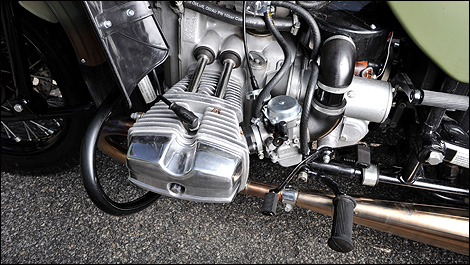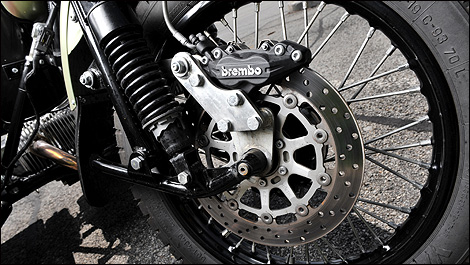With its four speeds and reverse gear, the old style crash box works well with the engine’s flat and broad torque curve. On the road you shift gears without waiting for the rpm to climb, and often end up in fourth gear at 50 km/h. Reverse is engaged via a lever on the right side of the tranny, after having carefully found the neutral position. Even though neutral is easy to find, the neutral indicator is rather temperamental and hard to read, and we ended up constantly fiddling around with the lever for nothing. I also did not like the long reverse ration, inexplicably longer than first in fact, making it less effective when trying to extricate yourself from an unfortunate situation, with much clutch slippage – not good.
 |
| Ural are not the only imitators of the BMW Boxer design, with its simple, logical and easy to fix layout. |
The two-wheel-drive versions (Gear-Up and Patrol) use the sidecar wheel to provide incredible traction, allowing it to clamber up hills normally reserved for quads and off-road bikes. However, as no differential allows for different rotation speeds between the driven wheels, such as in corners when the inside wheel travels a shorter distance than the outside one, the two-wheel-drive function can only be used off-road or on a slippery surface. A lever mounted near the right side of the swingarm dispatches power to the sidecar wheel.
Early post-war (1939-45 that is!) frame
The two-wheel drive Gear-Up used an Earl-type front suspension with forward facing swingarm, rather than the more popular fork found on the one-wheel-drive models. The short swing arm in front is controlled by two shock absorbers, with two more identical ones at the back and one for the sidecar’s suspension. By the way, the pre-load on all five shocks is adjustable, but not the damping.
The use of a front rocker arm suspension increases the stiffness of the steering system and provides a more stable base than a classic fork when subjected to the lateral forces generated in corners. Four attachment points link the sidecar to the classic tubular steel frame of the chassis. The rather short travel of the suspension gets a helping hand from the high and rather flexible tire side walls that act like balloon tires to absorb the little irregularities of the road.
 |
| Oh yes, the American standards impose a high level of braking efficiency. So out with the drum and in with the ubiquitous Brembo kit and cobbled-up bracket. It works fine by the way. |

